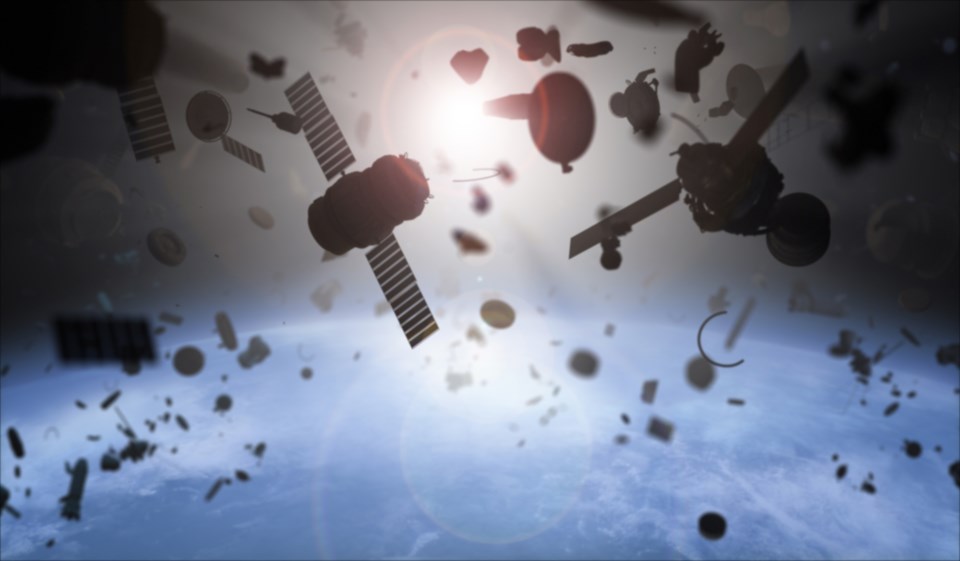We need new treaties to address the growing problem of space debris
Space debris represents the spread of our scorched-earth habits into space. Earth and the orbital space around it are a global commons to which we have been laying waste. And what’s worse, we appear powerless to prevent ourselves.
Since the dawn of the space age in 1957, our spacecraft have been jettisoning bits and pieces both deliberately (like launch shrouds) and inadvertently (like exploding fuel tanks). Then, to add insult to injury, dying spacecraft, following their last gasp, are left in orbit as useless relics.
Space flotsam
There are 15,888 pieces of debris larger than 10 centimetres in size, including some 2,000 pieces in or intersecting geostationary orbit, the rest being dominantly in the polar orbital band at 800-1,000 kilometres in altitude. Smaller sizes are even more plentiful — it’s estimated there are 500,000 pieces one centimetre in size, and 100 million pieces that are a millimetre in size, all rattling along at orbital speeds of eight to 12 kilometres a second (compared to a rifle bullet travelling at approximately one kilometre a second).
It’s a small wonder no astronauts have been seriously hurt yet. But spacecraft have: Cerise was the first documented case of a satellite being struck by debris in 1996. Since then, the situation has worsened.
In 2007, the Chinese, in a fit of muscle-flexing bravado, fired an anti-satellite missile at their defunct Fengyun-1C satellite at 860-kilometre altitude, creating a shower of 2,400 debris pieces larger than 10 centimetres, and 35,000 smaller pieces. This increased the total debris population by 30 per cent.
In 2009, a defunct Russian Cosmos satellite accidentally collided with an operational Iridium satellite at 790-kilometre altitude, generating two clouds of debris comprising 598 fragments from the Iridium satellite and 1,603 fragments from the Cosmos satellite.
Avoidance manouevres
The International Space Station has to be manoeuvred around twice a year to avoid incoming debris. If we do nothing, the debris problem will worsen until the Kessler Syndrome limit is surpassed. When this happens, debris will become self-perpetuating, creating an exponentially growing ring of projectiles around Earth, effectively entombing us and our planet for centuries to come. Attempts to curtail the growth of debris to date have been to no avail.
United Nations recommendations to boost ailing and dying satellites into so-called graveyard or decaying orbits have either been ignored or are ineffective.
Even more ominously, there’s expected to be large satellite operations launched in the near future to provide global services. Elon Musk’s space transportation company SpaceX envisages a constellation of 12,000 satellites. The prospects for the future look bleak and we are falling headlong towards entombment of our deteriorating planet.
However, it’s not all doom and gloom. The worst effects of growing debris can be alleviated by removing up to 10 of the largest pieces of debris per year. Perhaps unsurprisingly, Europe — given its greener credentials than most other space-faring powers — has been taking the lead in developing active debris removal techniques.
The European Union’s removeDEBRIS concept adopted harpoons and nets to capture defunct satellites. However, these are essentially ballistic and uncontrolled, introducing complex dynamic problems. These techniques can also potentially cause more debris if they fracture or fragment spacecraft while trying ensnare them.
The European Space Agency’s (ESA) e.Deorbit mission adopted robotic arms to remove, in the first instance, the defunct eight-tonne Envisat satellite. Unfortunately, ESA cancelled the mission due to a lack of a commercial market for space debris removal. Only if e.Deorbit is extended to incorporate commercial on-orbit servicing might it be revived at some unspecified time in the future.
Human shortcomings
This is a great shame as it leaves the most potentially dangerous source of debris — the huge Envisat — in orbit. Furthermore, it illustrates the failings of human nature.
Nothing will happen unless we see an opportunity for wealth or we are compelled to act. The only way for the latter is to impose a specific and new UN treaty built on top of the Outer Space Treaty to join the other five derivative UN space treaties.
This new treaty – let us call it the “Do Not Soil Your Own Doorstep and if You Must, Clean Up After Yourself” Treaty - must impose demands on space-faring nations to collectively clean up their pollution in orbit.
UN Space Treaties have worked in the past. In 1977, the Russian Cosmos-954 reconnaissance satellite, carrying 50 kilograms of uranium-235, accidentally re-entered Earth’s atmosphere without ejecting its nuclear reactor into a safe orbit as intended. Radioactive debris was scattered over a 600-kilometre track in northern Canada, and was cleaned up by the Canadians with American assistance. The UN Space Liability Convention was successfully invoked — for the first and only time — to persuade Russia to foot the majority of the bill.
Likewise, we need a new treaty to coerce us to act to clean up space debris. Without some form of coercion, the problem will grow until we are entombed by an impenetrable layer of space junk.![]()
- Alex Ellery, Associate Professor, Canada Research Chair in Space Robotics and Space Technology, Carleton University.
This article is republished from The Conversation under a Creative Commons license. Read the original article here.
